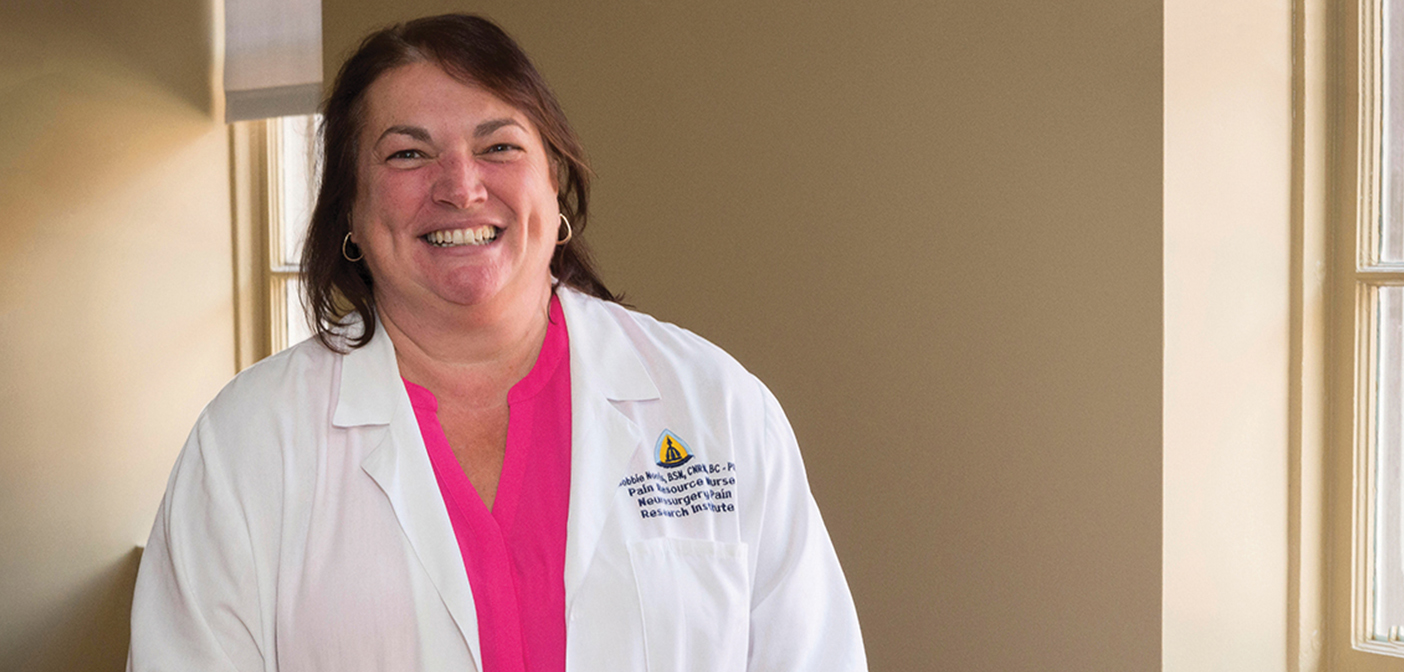For suffering patients, Pain Control and Comfort Menu can offer relief
At the Neurosurgery Pain Research Institute, the focus is on distraction.
Bobbie Norris, RN, CNRN, BC-RN, is a pain resource nurse at the institute, on the fourth floor of The Johns Hopkins Hospital’s Phipps Building. It’s a short walk but a world away from Zayed 12, where she treats patients fresh from surgery, out of anesthesia, and hurting. “I’d say 90 percent of the patients that we see are in acute post-operative pain,” she says.
Photo by Jon Christoferson Bobbie Norris of the Neurosurgery Pain Research Institute
“They’ve had brain tumors removed, spinal cord tumors removed, fusions done for pain, things like that, so we see them for mostly uncontrolled pain.”Rather than try to medicate the pain away with opioid medications that can leave patients in a fog and carry the risk of addiction, Norris and her staff go to the Pain Control and Comfort Menu. And the special of the day is, without fail, distraction.
The “menu” is actually a pamphlet spelling out the many things available to help patients—and their families—learn about and help control the worst of the pain. Sections are labeled “To Help You Sleep” (ear plugs or an eye shield), “To Help You Feel Comfortable” (warm/cold packs, extra pillows, etc.), “To Help You Relax” (stress ball, “guided imagery therapy,” pet therapy, and such), “To Help You Feel Better” (lip balm, pajama bottoms, lotion), and “For Your Entertainment” (books, movies, a deck of cards, wireless Internet service). And of course, there’s music, usually classical or “elevator.” On the Comfort Menu, the heavy metal is served rare(ly). “No head-banging,” Norris says, not needing to explain why.
Many of these items have always been available. The menu simply puts them all in one place so patients know that if they become necessary, they are just a menu selection away. And though there is an emphasis on lessening the need for medication, a mixed approach is the norm. “We know from the literature that for a patient who doesn’t have a lot of exposure to pain medication, distraction is just as good a pain control as low-dose opioids are.”
Norris adapted the Pain Control and Comfort Menu from similar programs she’d learned about at various conferences. The Pain Committee, which includes members from the Pharmacy and Medicine departments, and Service Excellence Department got behind it.
The proof that it works comes daily. A patient undergoes a full assessment, ranking the
“We know from the literature that for a patient who doesn’t have a lot of exposure to pain medication, distraction is just as good a pain control as low-dose opioids are.”
— Bobbie Norris, CNRN, BC-RN
discomfort on a scale of 0-10. Then comes the consultation and education, “here’s what we’re going to do, and here are the medications, this is the menu, physical therapy, and getting out of bed, it’s all these things … global treatment, if you will,” Norris explains. “And at the end of a 20-minute conversation, you ask them about their pain level and inevitably it’s lower. And you think, ‘But I haven’t done anything!’ It’s just the talking about it. You know, ‘Somebody really cares about me and my pain.’ We knew that there was something to it at that point.”

